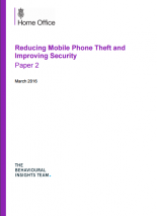In September 2014 the Home Office and the Behavioural Insights Team published the joint paper: Reducing Mobile Phone Theft and Improving Security1 . That paper used data from Crime Surveys (Crime Survey for England and Wales) conducted between 2005/06 and 2012/13, together with data from the Metropolitan Police about the theft of mobile phones in London between August 2012 and January 2014, to set out a detailed picture of how and when mobile phones are stolen and the types of phone most likely to be stolen. It also included the first Mobile Phone Theft Ratio.
When we published that material, we were conscious that the picture it presented might well have changed following the widespread introduction of device based solutions by manufacturers from September 2013 onwards. They were introduced to help reduce mobile phone theft. This paper provides an updated picture of mobile phone theft, including an updated Mobile Phone Theft Ratio, to provide a more contemporary picture capturing the impact that the security features introduced by manufacturers have had on levels of theft.
Our findings show:
- There has been a fall in levels of mobile phone theft since the introduction of device based solutions such as Apple iOS7 and Samsung Reactivation Lock;
- There has been a fall in the proportion of mobile phone thefts across all age groups and genders, except for 22-24 year old males;
- 18-21 year old females remain the most vulnerable to mobile phone theft; and
- Methods such as pick-pocketing and snatch theft, followed by theft of unattended items such as leaving a mobile phone on a bar or restaurant table, are the most common methods used by criminals.
